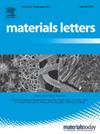Unveiling the synergistic mechanism of Co-Cu catalysts for efficient oxygen evolution reactions
IF 2.7
4区 材料科学
Q3 MATERIALS SCIENCE, MULTIDISCIPLINARY
引用次数: 0
Abstract
The development of highly active electrocatalysts for Oxygen Evolution Reactions (OER) is critical in the field of energy conversion and storage. Among potential candidates, diatomic catalysts have demonstrated the potential to outperform monoatomic counterparts, though comprehensive studies on their reaction mechanisms remain limited. In this study, a Co-Cu diatomic catalyst was computationally designed using density functional theory (DFT), and four reaction pathways involving multiple intermediates (*O, *OH, *OOH, *2OH, *O + *OH) were calculated. The results indicate that the Co-Cu diatomic catalyst exhibits superior catalytic performance on pathway II (H2O → *OH → *2OH → *OOH → O2) with an overpotential of 0.27 V, overcoming the limitations imposed by the active site of conventional anion exchange membrane (AEM) catalysts. The high catalytic activity is attributed to the synergistic interaction between the metal atoms, bypassing the high-energy barrier step typically observed in conventional pathways. In this mechanism, the Cu d-band center is close to the Fermi energy level, enhancing electron transfer, while Co provides a stable adsorption site and effectively regulates the adsorption and conversion of reaction intermediates. These findings offer new strategies for the rational synthesis of bimetallic catalysts.
揭示 Co-Cu 催化剂在高效氧气进化反应中的协同作用机制
开发用于氧进化反应(OER)的高活性电催化剂在能量转换和储存领域至关重要。在潜在的候选催化剂中,二原子催化剂已证明其潜力优于单原子催化剂,但对其反应机理的全面研究仍然有限。本研究利用密度泛函理论(DFT)计算设计了 Co-Cu 双原子催化剂,并计算了涉及多个中间产物(*O、*OH、*OOH、*2OH、*O + *OH)的四种反应途径。结果表明,Co-Cu 二原子催化剂在路径 II(H2O → *OH → *2OH → *OOH → O2)上表现出卓越的催化性能,过电位为 0.27 V,克服了传统阴离子交换膜催化剂活性位点的限制。高催化活性归功于金属原子之间的协同作用,绕过了传统途径中通常观察到的高能障步骤。在这一机制中,铜的 d 带中心接近费米能级,增强了电子转移,而钴则提供了一个稳定的吸附位点,有效地调节了反应中间产物的吸附和转化。这些发现为合理合成双金属催化剂提供了新的策略。
本文章由计算机程序翻译,如有差异,请以英文原文为准。
求助全文
约1分钟内获得全文
求助全文
来源期刊

Materials Letters
工程技术-材料科学:综合
CiteScore
5.60
自引率
3.30%
发文量
1948
审稿时长
50 days
期刊介绍:
Materials Letters has an open access mirror journal Materials Letters: X, sharing the same aims and scope, editorial team, submission system and rigorous peer review.
Materials Letters is dedicated to publishing novel, cutting edge reports of broad interest to the materials community. The journal provides a forum for materials scientists and engineers, physicists, and chemists to rapidly communicate on the most important topics in the field of materials.
Contributions include, but are not limited to, a variety of topics such as:
• Materials - Metals and alloys, amorphous solids, ceramics, composites, polymers, semiconductors
• Applications - Structural, opto-electronic, magnetic, medical, MEMS, sensors, smart
• Characterization - Analytical, microscopy, scanning probes, nanoscopic, optical, electrical, magnetic, acoustic, spectroscopic, diffraction
• Novel Materials - Micro and nanostructures (nanowires, nanotubes, nanoparticles), nanocomposites, thin films, superlattices, quantum dots.
• Processing - Crystal growth, thin film processing, sol-gel processing, mechanical processing, assembly, nanocrystalline processing.
• Properties - Mechanical, magnetic, optical, electrical, ferroelectric, thermal, interfacial, transport, thermodynamic
• Synthesis - Quenching, solid state, solidification, solution synthesis, vapor deposition, high pressure, explosive
 求助内容:
求助内容: 应助结果提醒方式:
应助结果提醒方式:


